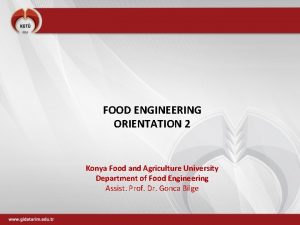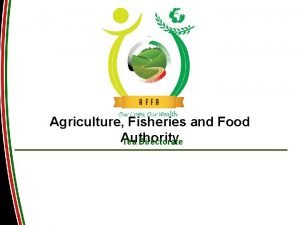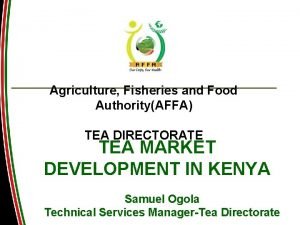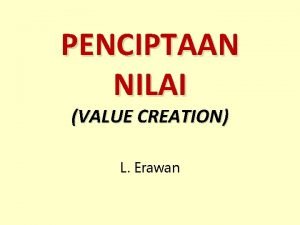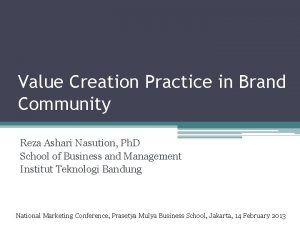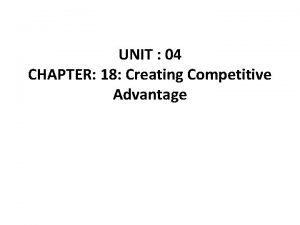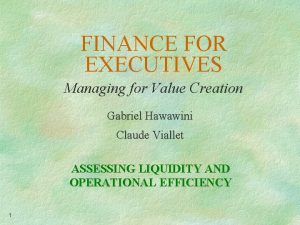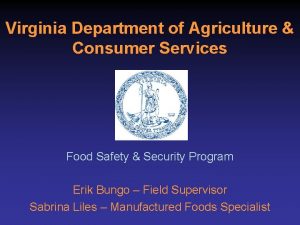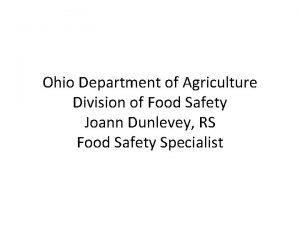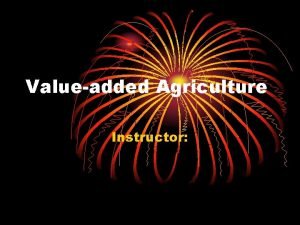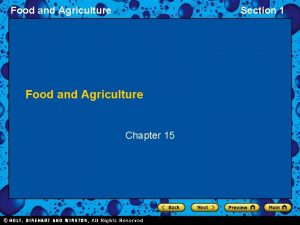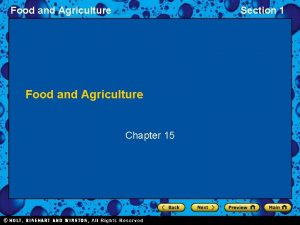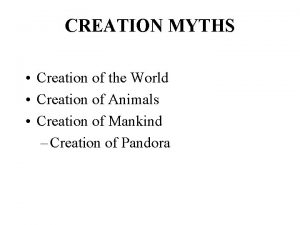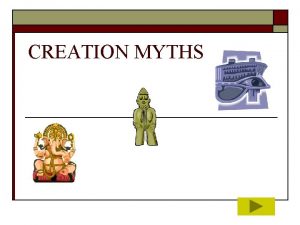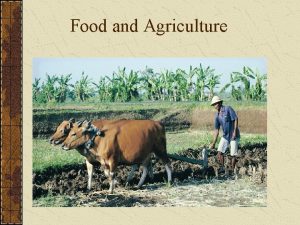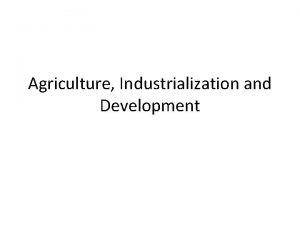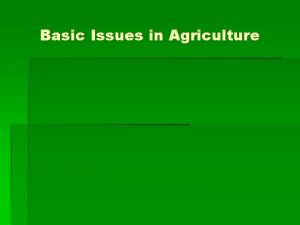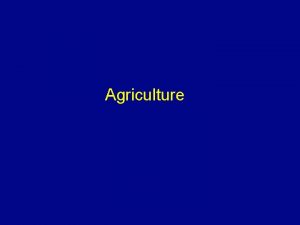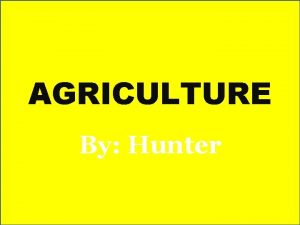Value Creation across the Food and Agriculture Value

















- Slides: 17

Value Creation across the Food and Agriculture Value Chain Maria Cucagna and Peter Goldsmith Department of Agricultural and Consumer Economics University of Illinois 1

Farm Share Evolution Proportion of one dollar food expenditure (%) 19 18, 42 18 17 16 15, 47 15 14 13 12 1993 1995 1997 1999 2001 2003 2005 2007 2009 2011 Year Farm Share 2

Motivation and Research Questions • Increasing spread between farm share and the marketing share • Lack of understanding of the term value creation • Lack of empirical studies measuring value creation within a value chain context. Research Questions: 1. What drives value creation in agribusiness? 2. Which chain members are creating the most value? 3. How can this be measured? 3

Agri-Food Value Chain Stage 1 Stage 2 Stage 3 Stage 4 Inputs Agricultural Production Processors Delivery to consumer -Chemicals -Agricultural inputs -Farm equipment - Farm products -Soft drinks -Brewers -Wineries -Packaged food -Food distribution -Groceries -Restaurants 4

The Concept of Value Creation in Food and Agribusiness To change a product current place, time, and form to characteristics more preferred in the marketplace. Coltrain (2000); USDA (2002) To add value to a raw product by taking it to at least the next stage of production. Anderson and Hanselka (2009) To perform an activity performed at another stage or to perform an activity never performed Amanor-Boadu (2003); Born and Bachmann (2006); Evans (2006, 2009) 5

Weaknesses of the Term Value Creation • The definitions of value creation provide a weak description of what value creation really means • Focus solely on the process and product levels • Fails to provide a measurement of value creation • There is no study measuring value creation in food and agribusiness • Inconsistent with the financial economics literature • Do not take into account the cost of capital 6

The Concept of Value Creation in Financial Economics • Traditional accounting measures for assessing firm performance • Stock Prices • Return on Equity (ROE) • Earning per Share (EPS) • Net Operating Profits After Taxes (NOPAT) • Inferior measures of the true value of a firm • Fail to measure the real value or performance of the firm because they do not account for the cost of capital 7

Economic Value Added (EVA) as a financial tool to measure value creation. • Adding value means to use the capital efficiently • Producing a return on capital above the cost of capital • Not necessarily related with profitability. • Research determining the superiority of EVA over traditional accounting measures of value creation • There is no research measuring value creation in a value chain perspective. • Nor applied to the food and agribusiness 8

Value Creation Metrics Economic Value Added Modified Economic Value Added Created Economic Value Added Persistent Economic Value Added 9

Data • This study uses a ten years panel data of 454 agri-food listed companies for the period 2003 -2012. • The main source of the data is Morningstar • This data provides financial information of worldwide companies. • Balance sheets • Income Statements • The cost of capital of each company is estimated by using WACC and CAPM models. 10

Empirical Model • 11

Results 12

Results • Stage I: Agricultural Inputs • Low value creator: No differences with Stage 2 in terms of EVA and MEVA • The efficient use of capital is low but persistent value creator • Stage 2: Agricultural Production • • The chain actor that least efficiently uses capital. The lowest outcome in the EVA, MEVA, PEVA and CEVA The probability of create value persistently is negative. The most commoditized sector 13

Results • Stage 3: Food Manufacturing • High value creator- Efficient use of capital • No differences with Stage 4 in terms of EVA and PEVA. • Stage 4: Deliver to Consumer • The chain node that most efficiently uses the operating capital • The highest MEVA of the entire value chain. • The highest probability to create value (in terms of CEVA) 14

Results Drivers of Value Creation - Firm size has a positive effect on the four metrics of value creation. - Increasing firm leverage by one unit increases the level of value creation by 3. 6 million dollars - Investing in Goodwill and Intangible has a positive effect on EVA, MEVA and CEVA - Increasing expenditures in R&D increases a firm’s EVA outcome - Decreasing COGS positively impacts firm level of value creation 15

Conclusion and Further Research • There is statistically significant evidence of differences in value creation levels across the food and agribusiness value chain. • Down-chain firms create most value. • Key drivers of value adding • Low cost of goods sold, R&D, Goodwill, Intangibles Assets • The definition of value creation or value adding in food and agribusiness should be consistent with the finance literature. • Therefore we offer the following definition: • “Food and agribusiness firms add value when they generate returns on capital that exceed the opportunity cost of employed capital. ” • Thus firms add value when they efficiently produce goods and services from the capital they employ. 16

Conclusion and Further Research • Complementarities among members in the value chain • Coordination • Horizontal and Vertical Coordination • Value chain performance improvement • Agri-food value chain as an entity • Identify if there are differences in value outcome among sectors within each stage. • Value creation analysis among sectors across the agri-food value chain 17
 Contoh value creation
Contoh value creation Value creation and value capture
Value creation and value capture Governance and value creation ratings
Governance and value creation ratings Konya food and agriculture university
Konya food and agriculture university Tea directorate
Tea directorate Ministry of food agriculture and fisheries denmark
Ministry of food agriculture and fisheries denmark Tea directorate
Tea directorate Unit 2 food food food
Unit 2 food food food Sequence of food chain
Sequence of food chain Arti value creation
Arti value creation How brand community practices create value
How brand community practices create value Chapter 18 creating competitive advantage
Chapter 18 creating competitive advantage Finance for executives: managing for value creation
Finance for executives: managing for value creation Virginia department of agriculture food safety
Virginia department of agriculture food safety Ohio cottage food law label
Ohio cottage food law label Value-added agriculture
Value-added agriculture Business intelligence objectives
Business intelligence objectives Hình ảnh bộ gõ cơ thể búng tay
Hình ảnh bộ gõ cơ thể búng tay



